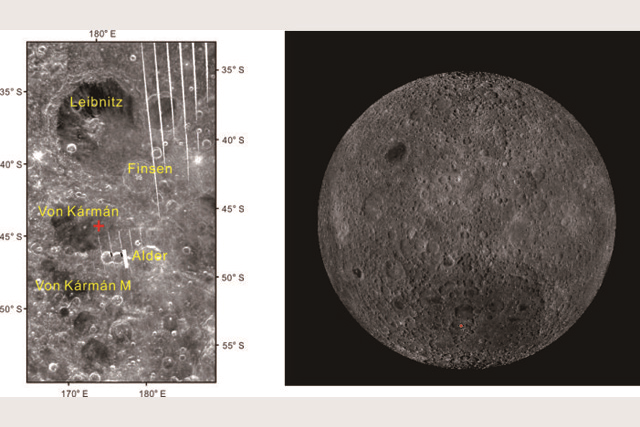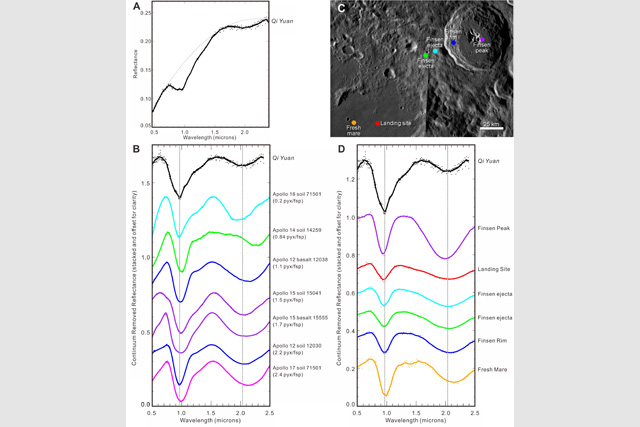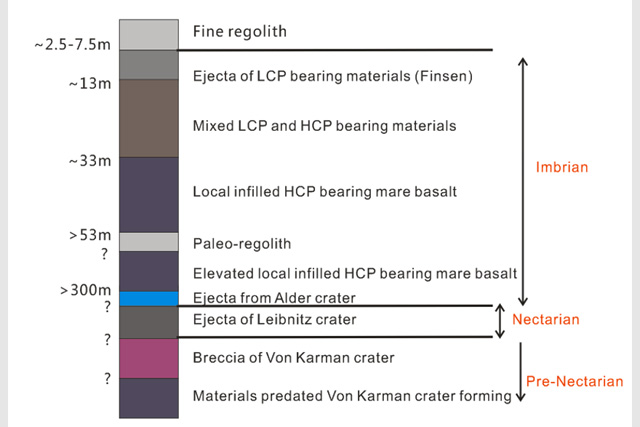The planetary geology team in which Associate Professor HUANG Jun and Prof. XIAO Long work in has published “Diverse rock types detected in the lunar South Pole–Aitken Basin by the Chang’E-4 lunar mission” in the prestigious journal Geology. They identify a variety of rock types including plagioclase- and pyroxene-rich materials in the landing region of the Chang’E-4 (CE-4), but not the recently reported olivine-rich materials.
The South Pole–Aitken (SPA) basin, located between the South Pole and Aitken crater on the far side of the Moon, is the largest confirmed lunar impact structure. The Von Kármáncrater (diameter = ~186 km), lying in the northwesternSPA basin, was formed in the pre-Nectarian.The Von Kármán crater floor was subsequently flooded with one or several generations of mare basalts during the Imbrian period. Numerous subsequent impact craters in the surrounding region delivered ejecta to the floor, together forming a rich sample of the SPA basin and farside geologic history. With its landing site located in the Von Kármán crater, the CE-4 achieved humanity’s first soft landing on the far side of the Moon.

Figure 1 The remote sensing image of the Von Kármán crater. CE-4 landing point is marked with red cross.
The team reports diverse rock types using the data of visible/near-infrared spectrometer (VNIS), landing camera (TCAM), terrain camera (TCAM), and panorama camera (PCAM) of the CE-4. The PCAM instrument observed a group of relatively light-toned rocks near a local depression. The VNIS instrument take a spectrum of one of the rocks, which the team informally names as “Qi Yuan”.

Figure 2 The images of “Qi Yuan”
It is the first in situvisible/near-infrared spectrum of a lunar rock. In comparison to the spectral properties of Apollo samples, the VNIS spectrum is most like pyroxene and feldspar-dominated mare soils and rocks with very little olivine (<4%). Qi Yuan could be an ejected block of plagioclase- and pyroxene- rich materials from Finsen crater that has been exposed by mass wasting, which should have exposed lower crust and upper mantle due to the enormous excavation depth.

Figure 3 The spectrum of “Qi Yuan” obtained by Yutu-2 and its analysis (Huang et al., 2020)
The team published “Geological Characteristics of Von Kármán Crater, Northwestern South Pole-Aitken Basin: Chang’E‐4 Landing Site Region” in JGR Planets in May of 2018, presenting detailed geological analysis of the landing region in the Von Kármán crater. The paper has received a lot of attention in the field and was among the top 20 most downloaded papers of the journal in 2017-2018.

Figure 4 Proposed stratigraphy of the landing region. (Huang et al., 2018)
The team also consits of members from the Shanghai Institute of Technical Physics, Chinese Academy of Sciences (CAS), Xi’an Institute of Optics and Precision Mechanics, CAS, Institute of Optics and Electronics, CAS, Institute of Space Mechanics and Electricity, China Academy of Space Technology, and Beijing Aerospace Flight Control Center.
Information of the papers:
Jun Huang*, Zhiyong Xiao*, Long Xiao*, Briony Horgan, Xiaoyi Hu, Paul Lucey, Xiao Xiao, Siyuan Zhao, Yuqi Qian, Hao Zhang, Chunlai Li, Rui Xu, Zhiping He, Jianfeng Yang, Bin Xue, Qi He, Jie Zhong, Hongyu Lin, Changning Huang, JianfengXie; Diverse rock types detected in the lunar South Pole–Aitken Basin by the Chang’E-4 lunar mission. Geology. https://doi.org/10.1130/G47280.1
Huang, J., Xiao, Z., Flahaut, J., Martinot, M., Head, J., Xiao, X., et al. ( 2018).Geological characteristics of Von Kármán crater, northwestern South Pole‐Aitken Basin: Chang'E‐4 landing site region. Journal of Geophysical Research: Planets, 123, 1684– 1700. https://doi.org/10.1029/2018JE005577
(Edited and translated from the Chinese version)